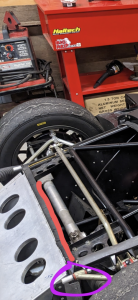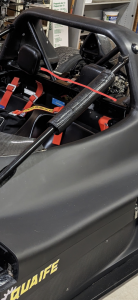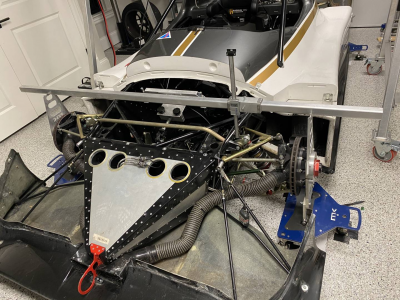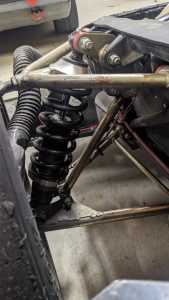
The little things
I'm sitting around with a buddy talking about making our race cars faster without adding power.
I'd be really interested in hearing the tips and tricks from the veterans here on what I can apply to my car.
Now granted tires will be number one but let's take tires out if the conversation.
My input here is changing the GDU final drive gears to the 3.54 (I think, highest numerical gear set) made a huge difference in accelerating out of the corners at my local track.
I'd love to hear any little thing you found or thought made a difference.
Good question, and a very deep topic. The short answer is driver plus car setup. It makes a huge difference in lap times with a well setup car versus one that is not well setup and this applies to all race cars that have the ability to tune the chassis.
Going back to driver -- the driver's job is to drive the car at the limit -- not less and not more (quoting another driving coach). That is a very difficult task and can take years of hard work and natural talent. The benefit to being an accomplished driver is you would be able to quickly determine what changes need to be made to the car setup on a particular condition at a particular track. As an example of the importance of driving skill, it is common for pro drivers to coach on the side at amateur race events. The pros will get in the customer's car during a test session and drive a few blistering fast laps, often a couple to several seconds faster than the customer's personal best. Then the coach will consult with the engineer(s) what deficiencies in the setup need to be addressed.
To become an expert driver you need to race a lot, drive a simulator, and like most difficult activities, have natural talent combined with work ethic and determination to improve.
The setup for a Radical is going to come down to tire pressure, brake bias, and chassis+aero tuning, along with all of the maintenance required to keep the car running well. There is a classic book on the subject: Tune to Win which is old but still relevant. Maintaining and adjusting setup requires scales, camber gauge, tow alignment apparatus, ride height bar, etc. Car setup is a deep topic and difficult to learn. Little things that are often overlooked matter. For example damper performance and eliminating suspension binding.
Yes, changing the gear ratio is part of the setup and is different for every track, but usually you can ask another Radical owner who is experienced with that track or figure it out pretty fast yourself. Generally you want to be at the rpm limit at top speed for a given track. I have actually had good luck on the simulator in determining the gear ratio using this rule of thumb and F2000 car sim. The F2000 in iRacing is nearly equivalent in lap times and top speed as a Radical SR3 1500cc. (one of the owner's manuals has a table of gear ratio and top speed at redline rpm)
Going back to racing ... In my limited experience, this is where you learn and improve the most. It's a humbling but thrilling experience. You will quickly discover how good or bad you are at driving at the limit, and you will pick up a lot of knowledge of maintenance and setup tuning from the technicians and engineers.
One tweak you can do which is very easy is to pump out all of the fuel in your car before a session, and add just what you need to finish the session. On a 1500 SR3, my rule of thumb is one gallon for 5 minutes. It is different for different tracks. If I come back with 1/2 gallon to pump out, I might want to add just a little more for the next session for safety. If more than a gallon is pumped out, then add less for the next session.
Some Radicals have a faulty fuel pump that cannot operate well with a near empty tank. If that is the case, then this is a good repair to make on your car. And if you don't have a pump-out, then add one.
Tire pressure is also pretty easy to set but it requires a couple of clean sessions and assistance to figure it out. If you cannot get clean laps at the limit, then it is pretty difficult to do this but it can still be done with feel and driving at the limit in several corners. Start with a target pressure of say 28 PSI for the Hankooks, get them up to temperature and pressure, preferrably a little over the target. Then have an assistant set tire pressure in pit lane equal all four tires set to 28 PSI. Drive a couple laps, then drop the pressure to 27.5, etc until your lap times increase and traction goes down. It takes very consistent driving at the limit to set the pressure but it makes a huge difference in your lap time, driveability, and confidence at high lateral forces.
Damper settings can make a dramatic difference in handling. I was at Sebring earlier this year and I was bouncing in the braking zone on two turns, causing my rear wheels to lock up. I compensated by increasing front bias and braking earlier and softer in those two turns, but the bias settiing reduced my braking effectiveness throughout the other corners resulting in poor lap times. I relayed this to my race team, and we made an adjustment to rear rebound (we removed rebound resistance). The rear tires stayed on the ground much better after the adjustment, and I could then remove some front bias, brake deeper in those bouncy brake zones, and my entire braking throughout the course improved. 2 seconds better lap time in the same car/tires/driver/conditions.
If your corner weights are off, then you cannot brake optimally, and your car may be less predictable, leading to loss of confidence, less grip under high lateral loads, which adds seconds to your lap times. Many setup issues can be subtle and difficult to diagnose.
Dampers should be dyno'ed regularly, particularly new cars. You cannot assume a brand new anything works optimally on a race car. If a damper does not dyno check well, then it gets rebuilt.
The suspension is meant to move freely. I'm not saying the car should feel like a soft mattress, but the moving elements of the suspension should not bind. On public road vehicles, the suspension provides comfort. In a race car, its job is squeezing every last bit of traction out of the tires. When the car is at the limit of traction, every tiny improvement in removing suspension binding and optimizing damper performance matters, yielding more traction, and therefore better lap times.
All a very good read so far, thank you for the input.
I don't have adjustable dampers, so I think the only only adjustability I have is my camber and tow for the front and camber for the rear. David, do you run the factory camber? I currently have mine set to -3.2° on the front
I'm going to definitely test the tire pressure suggestion on my next lapping day. That's something I have neglected.
I run factory camber and factory settings for everything as the starting place for each event, then make minor adjustments in the dampers and aero if needed. I believe Radical has the cars figured out well, and I don't know enough or have sufficient time to delve into it further. I also do not run with front diveplanes unless it is wet -- I have never had trouble with high speed understeer in dry conditions without the diveplanes. For SR10, I see that they are always used. For rear wing, in the dry it is usually five or six holes from the bottom. If my rear end begins to step out at 5, then I increase the wing one hole to 6. On wet I think 7 from the bottom. Typically, when the tires start to lose traction, I feel the rear stepping out. You can really feel the difference on tracks that have a high speed long corner/carusel where you are often flat on the throttle until the back end begins to step out. That is where tire pressure and wing setting helps a lot. So for example at COTA and Rd America, I will typically try to use 5 from the bottom on rear wing with first session on new tires, and then if necessary add wing as the tires begin to fall off. These tracks have long straights so you want to trim out down force, but you need to keep the back end down on high speed turns.
Camber is easy to change, however a change in camber changes the ride height, which means it changes the rake, and that can throw the balance off, so I always just use the factory camber settings and ride height with the Hankook tires.
What tire temperature do you see when "hot" and 30'ish psi?
Edit: disregard for gen 1 & 2 SR3
The measuring points are directly under the high point of the tires for front and rear. Note that the bar that is used (see gen 3 owner's manual) has the rear drop height measured from 2 inches above the tires -- I think that might be because if a bar was laid flat atop the rear tires it would hit the exhaust?
I am unsure whether the drop heights which are given in the gen 3&4 owners manuals apply to earlier generation Radicals. The procedure in those owner's manuals use direct measured ride height (front of the chassis and below roll bar), whereas in gen 3 and above the ride height is indirectly measured using the drop-height measurement and table. The drop height for the front/rear should be around 163mm/213mm. If your car drop heights are in that ballpark, then I would probably use the drop height method but I have not worked on gen 1&2 Radicals. It may be that the chassis and drop heights are different than the later cars.
Ugh, I apologize. I am so conditioned to measuring drop heights that I thought your drawing and question referred to that. I see that you understand the manual and ride height measuring points.
I would say that you have it correct. The manual says front of chassis and the bulkhead behind the seat, so your drawings looks correct to me.
*Measure at those locations between the ground and the chassis, with the car situated on a level and flat surface. If your surface or projected surface is not flat, then there is no way to obtain an accurate measurement. This is why the drop-height indirect method is much easier/better. It might be possible to contact Radical to obtain drop height to ride height calculated data for your generation SR3.
Posted by: @meatmanWhat tire temperature do you see when "hot" and 30'ish psi?
I usually just go by max pressure instead of tire temperature because both will be different based on track and weather. It is somewhat inexact, but typically about 4 hard laps will bring the tire temps and pressure up to a maximum. It might require more or less laps depending on the car, weather conditions, and how hard one is driving. Hard braking will quickly build heat in the rotors and tire surface which is transferred to the wheels, which heats up the air in the tires, and builds pressure.
There are three youtube videos on the Safe is Fast channel about race car setup by David Donohue and Jay O'Connell. They are short videos but densely packed with useful information. Jay says that shock absorbers are the most important piece to get the most grip out of the car.
Intro Basic Chassis Set Up 1 - Camber, Castor, Toe, and Ackerman
Springs Basic Chassis Set Up 2 - Springs, Shocks, Anti-Roll Bars and Bump Rubbers
Basic Chassis Set Up 3 - Ride Height, Rake and Weight Jackers
Defintley gonna watch these 10X or more!
Posted by: @meatmanSo if I don't have an adjustable front push rod my brain tells me the only way to set ride height is by the spring perch?
If I can only set my right height by the spring perch it will probably screw up the spring preload.
I think that is right, but it may be that one of the settings is less critical than the other, or there may be a sweet spot for preload and ride height.





